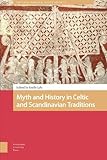Myth and History in Celtic and Scandinavian Traditions / ed. by Emily Lyle.
Material type: TextSeries: The Early Medieval North Atlantic ; 12Publisher: Amsterdam : Amsterdam University Press, [2021]Copyright date: ©2021Description: 1 online resource (302 p.)Content type:
TextSeries: The Early Medieval North Atlantic ; 12Publisher: Amsterdam : Amsterdam University Press, [2021]Copyright date: ©2021Description: 1 online resource (302 p.)Content type: - 9789048554065
- Celts -- History
- Mythology, Celtic
- Mythology, Norse
- Archaeology by period / region
- Art and Material Culture
- Cultural studies
- European history
- History, Art History, and Archaeology
- Interdisciplinary Studies
- Literary Theory, Criticism, and History
- Medieval Studies
- HISTORY / Europe / Ireland
- Mythology, Vikings, Irish Pagan Gods, Saxo Grammaticus, Snorri Sturluson
- 299/.16113 23
- BL900 .M98 2021
- online - DeGruyter
| Item type | Current library | Call number | URL | Status | Notes | Barcode | |
|---|---|---|---|---|---|---|---|
 eBook
eBook
|
Biblioteca "Angelicum" Pont. Univ. S.Tommaso d'Aquino Nuvola online | online - DeGruyter (Browse shelf(Opens below)) | Online access | Not for loan (Accesso limitato) | Accesso per gli utenti autorizzati / Access for authorized users | (dgr)9789048554065 |
Frontmatter -- Contents -- Preface -- Introduction -- Celtic Tradition -- 1 The Nature of the Fomoiri: The Dark Other in the Medieval Irish Imagination -- 2 Tuatha Dé and Fomoiri in Cath Maige Tuired -- 3 Exploring Cath Maige Tuired through the Concept of Hybridity -- 4 How Time Flies in the Cath Maige Tuired -- 5 The Idols of the Pagan Irish in the Medieval Literary Imagination -- 6 Myth as a Historical Resource : The Case of Orgain Denna Ríg (The Destruction of Dinn Ríg) -- 7 Hagiography as Political Documentation : The Case of Betha Beraigh (The Life of St Berach) -- Scandinavian Tradition -- 8 Baldr’s Achilles’ Heel? About the Scandinavian Three-God B-Bracteates -- 9 The Cult of Óðinn in the Early Scandinavian Warrior Aristocracy -- 10 Myth to History in Saxo -- 11 The Scylding Dynasty in Saxo and Beowulf as Disguised Theogony -- 12 Loki the Slandered God? Selective Omission of Skaldic Citations in Snorri Sturluson’s Edda -- 13 Ymir, Baldr, and the Grand Narrative Arc of Mythological History -- Index
restricted access online access with authorization star
http://purl.org/coar/access_right/c_16ec
Myth and History in Celtic and Scandinavian Traditions explores the traditions of two fascinating and contiguous cultures in north-western Europe. History regularly brought these two peoples into contact, most prominently with the Viking invasion of Ireland. In the famous Second Battle of Moytura, gods such as Lug, Balor, and the Dagda participated in the conflict that distinguished this invasion. Pseudohistory, which consists of both secular and ecclesiastical fictions, arose in this nexus of peoples and myth and spilled over into other contexts such as chronological annals. Scandinavian gods such as Odin, Balder, Thor, and Loki feature in the Edda of Snorri Sturluson and the history of the Danes by Saxo Grammaticus. This volume explores such written works alongside archaeological evidence from earlier periods through fresh approaches that challenge entrenched views.
Mode of access: Internet via World Wide Web.
In English.
Description based on online resource; title from PDF title page (publisher's Web site, viewed 01. Dez 2022)


